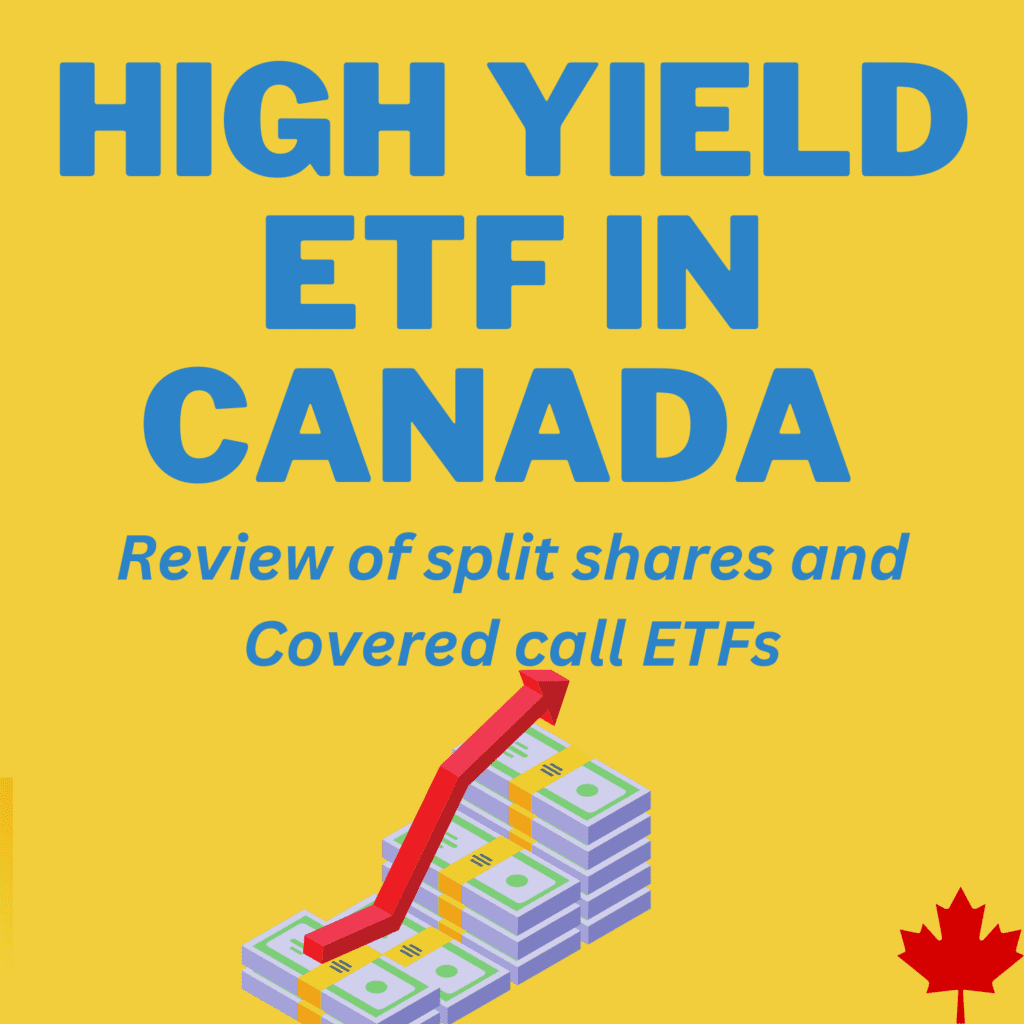In today’s investment landscape, where generating attractive yields is a primary concern for many investors, high yield ETFs have emerged as promising options in Canada. In this post, we will delve into the world of high yield ETF, focusing on two distinct categories: covered call ETFs and split shares funds.
Covered call ETFs harness the power of options trading strategies to enhance income generation. By selling call options on their underlying securities, these ETFs aim to generate additional premium income for investors. On the other hand, split shares funds employ creative financial engineering techniques to divide dividends and growth into separate exchange vehicles, catering to both conservative and aggressive investors.
Throughout this discussion, we will explore the dividend yields and historical performance of these high-yield investments. Furthermore, we will conduct a comprehensive analysis, carefully examining the benefits and drawbacks of each investment type, enabling you to make informed decisions tailored to your investment goals and risk tolerance.
Split chares fund – Risks and rewards
What are Split Shares?
Split shares present an investment opportunity that can be advantageous for both cautious and bold investors, despite their initial intricacy. These distinctive financial instruments were created by dividing dividend-paying stocks into two separate exchange entities: preferred shares and Class A shares. Here is a detailed explanation of how they function:
Preferred shares cater specifically to conservative investors and provide a regular dividend determined by the issuing company. Notably, preferred shares do not entail any management expense ratio (MER), as this cost is covered by the Class A shares.
Conversely, Class A shares target daring investors who seek to leverage their investments. This leverage is achieved through the structural design of the product, rather than conventional borrowing methods. To better comprehend this concept, let’s simplify it using a few illustrations.
Summary table
| Aspect | Preferred Shares | Class A Shares |
|---|---|---|
| Targeted Investors | Conservative investors | Aggressive investors |
| Dividend | Regular dividend set by the issuing company | No direct dividend; excess dividends and growth from preferred shares |
| Management Expense | No management expense ratio (MER) | MER paid by Class A shares |
| Leverage | Not based on borrowing money; structural leverage | Takes advantage of leverage through product design |
| Loss Impact | Draws from Class A shares to maintain dividend | Losses can be amplified; may reduce or halt dividend payments |
| Share Value | Generally sticks close to the issue price | Share value can fluctuate due to bidding on the stock exchange |
| Repurchase Option | Issuing company may buy back preferred shares | Preferred shares can be retained or repurchased by the issuing company |
| Term | Typically five-year term | – |
Risks associated with split share funds
Unfortunately, many individuals are solely attracted to the potential for high returns without fully considering the underlying assets and associated risks with Split share funds.
Underlying asset is subject to market fluctuations
One aspect that is often overlooked is the risk of potential declines in asset value. Investments, including split share funds, are subject to market fluctuations, and the value of the underlying assets can decrease. Without recognizing this risk, investors may face unexpected losses if the market experiences a downturn.
During a financial crisis, the combination of investment losses and the need for cash flow can create a challenging situation. This is particularly relevant to split share funds, as they rely on the income generated from the underlying assets to distribute dividends to shareholders. If the value of the assets declines significantly, it may lead to reduced dividend payments, affecting investors who rely on those payments for their cash flow needs.
Concentration risk
Furthermore, investors should be aware that sector-focused split share funds, can be riskier compared to diversified portfolios. Concentrating investments in a specific sector increases vulnerability to sector-specific risks and market conditions. Diversification across multiple sectors can help mitigate this risk and provide a more balanced approach to investment. It’s important to note that fees associated with split share funds and similar investments tend to be on the higher side. These fees can erode overall returns, reducing the net gains that investors receive.
Limited potentiel growth
While split share funds offer the potential for extra income through covered call strategies, it is crucial to recognize that these strategies limit the upside growth potential. By writing covered call options, investors receive premiums but sacrifice the opportunity to fully benefit from any substantial price increases in the underlying security.
Moreover, writing covered call options restricts the amount a company can realize from the security. This restriction can impact portfolio returns, as potential profits from selling the security are limited by the call option agreement.
Canadian investors interested in split share funds should approach their investment decisions with a thorough understanding of these factors. It is advisable to educate themselves about investment principles, risk management strategies, and the specific features of split share funds.
Covered Call ETFs – Risks and rewards
Can you lose money on a Covered Call ETF?
The short answer is yes. Covered call ETFs are volatile and the returns depend greatly on the performance of the underlying asset. Even if you receive generous dividends, a low price performance of the ETF can wipe out all the benefits. It’s preferable to hold these type of ETFs for the long term.
Expected investment outcome with covered call ETFs
In a robust bull market, where the price of the underlying stock rises above the strike price plus the option premium, the covered call writer will underperform.
Due to earning the option premium, the covered call writer can normally anticipate to outperform merely holding the stock in flat, decreasing, and mildly rising markets.
| Covered call strategy | |
| Bull Market | lags in terms of performance |
| Modest Bull Market | Outperforms the index |
| Volatile market (frequent ups and downs) | Outperforms the index |
| Beat market | Outperforms the index |
10 Best Covered Call ETF Canada – High dividend yield
JEPI ETF REVIEW: JPMorgan Equity Premium Income
List of High Yield ETF Canada: Price and Dividend yield
| TICKER | DIV YIELD |
|---|---|
| DGS -DIVIDEND GROWTH SPLIT CORP | 23.67% |
| CEMI -CIBC EMERGING MKT EQUITY INDEX ETF UNIT | 18.21% |
| FTN -FINANCIAL 15 SPLIT CORP | 17.02% |
| DFN -DIVIDEND 15 SPLIT CORP | 16.88% |
| PIC.A -PREMIUM INCOME CORP | 16.52% |
| BK -CANADIAN BANC CORP | 15.99% |
| HMAX -HAMILTON CDN FINANCIALS YD MAX ETF UNITS CL E | 15.05% |
| ENCC -HORIZONS CDN OIL & GAS EQUITY COVER | 14.95% |
| LCS -ROMPTON LIFECO SPLIT CORP | 14.80% |
| CALL -EVOLVE US BANKS ENHANCED YIELD FUND HEDGED UNITS | 14.15% |
| LBS -LIFE & BANC SPLIT CORP | 13.81% |
| HYLD -HAMILTON ENHANCED US COVE CALL ETF UNIT UNHEDGED | 13.02% |
| SBC -BROMPTON SPLIT BANC CORP | 12.55% |
| NXF -CI ENERGY GIANTS COVERED CALL HEDGED COMMON UNITS | 12.45% |
| GDV -GLOBAL DIVIDEND GROWTH SPLIT CORP | 12.06% |
| QQCC -HORIZONS NASDAQ-100 COVERED CALL ET | 11.82% |
| ZWK -BMO COVERED CALL US BANKS ETF CAD UNITS | 11.79% |
| BANK -EVOLVE CDN BKS & LIFE ENHA YLD INX UNHEDGED UNIT | 11.51% |
| HHLE -HARVEST HEALTHCARE LEADERS ENHANCED CL A UNITS | 10.80% |
| HDIF -HARVEST DIVERSIFIED MONTHLY INC ETF UNIT CL A | 10.65% |
| ENS -E SPLIT CORP | 10.39% |
| PDV -PRIME DIVIDEND CORP | 10.25% |
| ETHY -PURPOSE ETHER YIELD ETF ETF | 10.10% |
| DS -DIVIDEND SELECT 15 CORP | 10.05% |
| HUTE -HARVEST EQUAL WEIGHT GLOBAL UTILS CL A UNITS | 10.05% |
| HDIV -HAMILTON ENHANCED MLTI SCTR COVE CA EL E UNIT | 10.03% |
| BEPR -BROMPTON FLAHERTY & CRUMRINE ENHANC UNIT | 10.00% |
| ETSX -EVOLVE S&P/TSX 60 ENHANCED YIELD FD UNHEDGED ETF UNITS | 9.83% |
| CBNK -MULVIHILL CDN BK ENHANCED YIELD ETF UNIT | 9.74% |
| BMAX -BROMPTON ENHANCED MUL ASSET INC ETF UNIT | 9.67% |

Performance comparison – High Yield ETF Canada
| TICKER | 3-MONTH PERF | YTD PERF | YEARLY PERF | 1-Y BETA |
|---|---|---|---|---|
| DGS | −1.55% | −11.67% | 1.40% | 2.10 |
| CEMI | 0.12% | 0.85% | 1.59% | 0.40 |
| FTN | −2.42% | −4.42% | −6.74% | 0.82 |
| DFN | −2.47% | −6.57% | −10.34% | 0.92 |
| PIC.A | −23.72% | −30.01% | −30.70% | 0.82 |
| BK | −1.50% | −1.58% | −4.38% | 0.42 |
| HMAX | −2.29% | −9.60% | −9.60% | 0.85 |
| ENCC | −1.13% | −7.06% | −10.15% | 1.04 |
| LCS | 18.98% | 36.63% | 71.27% | 2.68 |
| CALL | −4.42% | −28.38% | −31.61% | 1.48 |
| LBS | 0.12% | 0.35% | −3.66% | 0.91 |
| HYLD | 3.75% | 4.71% | −6.04% | 0.92 |
| SBC | −13.33% | −16.87% | −16.65% | 0.84 |
| NXF | 0.17% | −6.96% | 0.35% | 1.31 |
| GDV | −2.93% | −7.01% | −6.66% | 0.58 |
| QQCC | 5.95% | 18.43% | 14.80% | 0.53 |
| ZWK | −6.13% | −31.05% | −31.54% | 1.23 |
| BANK | 0.94% | 0.67% | −1.32% | 1.20 |
| HHLE | 0.89% | −3.61% | 0.59% | 0.53 |
| HDIF | 1.14% | −0.50% | −4.32% | 1.07 |
| ENS | −0.53% | −0.86% | −0.20% | 0.63 |
| PDV | −5.41% | −17.65% | −33.33% | −0.57 |
| ETHY | 3.37% | 37.67% | 44.81% | 1.38 |
| DS | −11.08% | −13.42% | −17.96% | 0.21 |
| HUTE | −4.06% | −3.15% | −4.24% | 0.64 |
| HDIV | −0.38% | −0.70% | 0.71% | 1.13 |
| BEPR | 0.96% | −8.40% | −11.95% | 0.46 |
| ETSX | −0.71% | −2.83% | −2.83% | 0.82 |
| CBNK | −2.44% | −4.01% | −7.58% | 1.16 |
| BMAX | 1.55% | −1.74% | 3.16% | 0.71 |
Review of UMAX: Hamilton Utilities Yield Maximizer ETF (13% Target yield)

